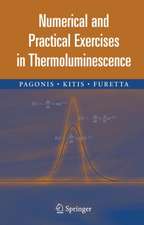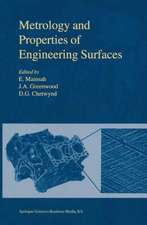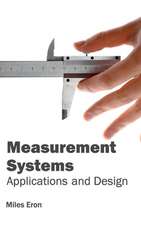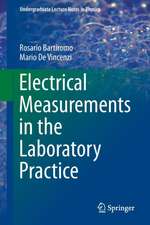Synergetics of Measurement, Prediction and Control: Springer Series in Synergetics, cartea 68
Autor Igor Grabec, Wolfgang Sachseen Limba Engleză Paperback – 15 noi 2011
This monograph is written for students, scientists and engineers in academia and industry who are interested in experimental work related to the adaptive modeling of natural laws, the development of sensory-neural networks, intelligent control, synergetics and informatics. No specific knowledge of advanced mathematics is presupposed. Examples taken from physics, engineering, medicine and economics demonstrate the applicability of such intelligent systems.
Din seria Springer Series in Synergetics
- 15%
 Preț: 653.14 lei
Preț: 653.14 lei - 17%
 Preț: 430.21 lei
Preț: 430.21 lei - 17%
 Preț: 495.47 lei
Preț: 495.47 lei -
 Preț: 392.37 lei
Preț: 392.37 lei -
 Preț: 396.02 lei
Preț: 396.02 lei -
 Preț: 400.10 lei
Preț: 400.10 lei -
 Preț: 391.02 lei
Preț: 391.02 lei - 15%
 Preț: 641.38 lei
Preț: 641.38 lei - 18%
 Preț: 739.00 lei
Preț: 739.00 lei - 15%
 Preț: 645.60 lei
Preț: 645.60 lei - 15%
 Preț: 637.75 lei
Preț: 637.75 lei - 18%
 Preț: 727.31 lei
Preț: 727.31 lei - 20%
 Preț: 481.77 lei
Preț: 481.77 lei -
 Preț: 398.15 lei
Preț: 398.15 lei - 18%
 Preț: 742.97 lei
Preț: 742.97 lei - 15%
 Preț: 647.40 lei
Preț: 647.40 lei -
 Preț: 416.64 lei
Preț: 416.64 lei -
 Preț: 397.76 lei
Preț: 397.76 lei -
 Preț: 391.99 lei
Preț: 391.99 lei - 15%
 Preț: 644.49 lei
Preț: 644.49 lei -
 Preț: 386.99 lei
Preț: 386.99 lei - 20%
 Preț: 574.08 lei
Preț: 574.08 lei -
 Preț: 387.58 lei
Preț: 387.58 lei - 15%
 Preț: 533.53 lei
Preț: 533.53 lei -
 Preț: 396.02 lei
Preț: 396.02 lei -
 Preț: 390.25 lei
Preț: 390.25 lei -
 Preț: 392.37 lei
Preț: 392.37 lei -
 Preț: 396.40 lei
Preț: 396.40 lei -
 Preț: 408.16 lei
Preț: 408.16 lei - 18%
 Preț: 1116.09 lei
Preț: 1116.09 lei -
 Preț: 397.76 lei
Preț: 397.76 lei - 18%
 Preț: 971.64 lei
Preț: 971.64 lei - 15%
 Preț: 644.30 lei
Preț: 644.30 lei -
 Preț: 386.81 lei
Preț: 386.81 lei -
 Preț: 398.15 lei
Preț: 398.15 lei
Preț: 398.92 lei
Nou
Puncte Express: 598
Preț estimativ în valută:
76.34€ • 81.63$ • 63.65£
76.34€ • 81.63$ • 63.65£
Carte tipărită la comandă
Livrare economică 17 aprilie-01 mai
Preluare comenzi: 021 569.72.76
Specificații
ISBN-13: 9783642643590
ISBN-10: 3642643590
Pagini: 484
Ilustrații: XX, 458 p.
Dimensiuni: 155 x 235 x 25 mm
Greutate: 0.67 kg
Ediția:Softcover reprint of the original 1st ed. 1997
Editura: Springer Berlin, Heidelberg
Colecția Springer
Seria Springer Series in Synergetics
Locul publicării:Berlin, Heidelberg, Germany
ISBN-10: 3642643590
Pagini: 484
Ilustrații: XX, 458 p.
Dimensiuni: 155 x 235 x 25 mm
Greutate: 0.67 kg
Ediția:Softcover reprint of the original 1st ed. 1997
Editura: Springer Berlin, Heidelberg
Colecția Springer
Seria Springer Series in Synergetics
Locul publicării:Berlin, Heidelberg, Germany
Public țintă
ResearchCuprins
1. Introduction.- 1.1 Goal.- 1.2 Relation to Other Scientific Fields.- 1.3 Plan of the Monograph.- 2. A Quantitative Description of Nature.- 2.1 Synergetics of Natural Phenomena.- 2.2 A Description of Nature.- 2.3 Fundamentals of Quantitative Description.- 2.4 Fundamentals of Physical Laws.- 2.5 The Random Character of Physical Variables.- 2.6 Expression of Natural Laws by Differential Equations.- 2.7 Methods of Empirical Modeling.- 2.8 Introduction to Modeling by Neural Networks.- 3. Transducers.- 3.1 The Role of Sensors and Actuators.- 3.2 Sensors and Actuators of Biological Systems.- 3.3 Operational Characteristics of Transducers.- 3.4 Fabricated Transducers.- 3.5 Transducers in Intelligent Measurement Systems.- 3.6 Future Directions in Transducer Evolution.- 4. Probability Densities.- 4.1 Estimation of Probability Density.- 5. Information.- 5.1 Some Basic Ideas.- 5.2 Entropy of Information.- 5.3 Properties of Information Entropy.- 5.4 Relative Information.- 5.5 Information Measure of Distance Between Distributions.- 6. Maximum Entropy Principles.- 6.1 Gibbs Maximum Entropy Principle.- 6.2 The Absolute Maximum Entropy Principle.- 6.3 Quantization of Continuous Probability Distributions.- 7. Adaptive Modeling of Natural Laws.- 7.1 Probabilistic Modeler of Natural Laws.- 7.2 Optimization of Adaptive Modeler Performance.- 7.3 Stochastic Approach to Adaptation Laws.- 7.4 Stochastic Adaptation of a Vector Quantizer.- 7.5 Perturbation Method of Adaptation.- 7.6 Evolution of an Optimal Modeler and Perturbation Method.- 7.7 Parametric Versus Non-Parametric Modeling.- 8. Self-Organization and Formal Neurons.- 8.1 Optimal Storage of Empirical Information in Discrete Systems.- 8.2 Adaptive Vector Quantization and Topological Mappings.- 8.3 Self-Organization Based on the Absolute Maximum-Entropy Principle.- 8.4 Derivation of a Generalized Self-Organization Rule.- 8.5 Numerical Examples of Self-Organized Adaptation.- 8.6 Formal Neurons and the Self-Organization Process.- 9. Modeling by Non-Parametric Regression.- 9.1 The Problem of an Optimal Prediction.- 9.2 Parzen’s Window Approach to General Regression.- 9.3 General Regression Modeler, Feedback and Recognition.- 9.4 Application of the General Regression Modeler.- 10. Linear Modeling and Invariances.- 10.1 Relation Between Parametric Modeling and Invariances.- 10.2 Generalized Linear Regression Model.- 10.3 Sequential Adaptation of Linear Regression Model.- 10.4 Transition from the Cross- to Auto-Associator.- 11. Modeling and Forecasting of Chaotic Processes.- 11.1 Modeling of Chaotic Processes.- 11.2 Examples of Chaotic Process Forecasting.- 11.3 Forecasting of Chaotic Acoustic Emission Signals.- 11.4 Empirical Modeling of Non-Autonomous Chaotic Systems.- 11.5 Cascade Modeling of Chaos Generators.- 12. Modeling by Neural Networks.- 12.1 From Biological to Artificial Neural Networks.- 12.2 A Linear Associator.- 12.3 Multi-layer Perceptrons and Back-Propagation Learning.- 12.4 Radial Basis Function Neural Networks.- 12.5 Equivalence of a Radial Basis Function NN and Perceptrons.- 13. Fundamentals of Intelligent Control.- 13.1 Introduction.- 13.2 Basic Tasks of Intelligent Control.- 13.3 The Tracking Problem.- 13.4 Cloning.- 13.5 An Empirical Approach to Optimal Control.- 14. Self-Control and Biological Evolution.- 14.1 Modeling of Natural Phenomena by Biological Systems.- 14.2 Joint Modeling of Organism and Environment.- 14.3 An Operational Description of Consciousness.- 14.4 The Fundamental Problem of Evolution.- A. Fundamentals of Probability and Statistics.- A.1 Sample Points, SampleSpace, Events and Relations.- A.2 Probability.- A.3 Random Variables and Probability Distributions.- A.4 Averages and Moments.- A.5 Random Processes.- A.6 Sampling, Estimation and Statistics.- B. Fundamentals of Deterministic Chaos.- B.1 Instability of Chaotic Systems.- B.2 Characterization of Strange Attractors.- B.3 Experimental Characterization of Chaotic Phenomena.- References.
Textul de pe ultima copertă
The electronic processing of information permits the construction of intelligent systems capable of carrying out a synergy of autonomous measurement, the modeling of natural laws, the control of processes, and the prediction or forecasting of a large variety of natural phenomena. In this monograph, a statistical description of natural phenomena is used to develop an information processing system capable of modeling non-linear relationships between sensory data. The system, based on self-organized, optimal preservation of empirical information, applies these relationships for prediction and adaptive control.
This monograph is written for students, scientists and engineers in academia and industry who are interested in experimental work related to the adaptive modeling of natural laws, the development of sensory-neural networks, intelligent control, synergetics and informatics. No specific knowledge of advanced mathematics is presupposed. Examples taken from physics, engineering, medicine and economics demonstrate the applicability of such intelligent systems.
This monograph is written for students, scientists and engineers in academia and industry who are interested in experimental work related to the adaptive modeling of natural laws, the development of sensory-neural networks, intelligent control, synergetics and informatics. No specific knowledge of advanced mathematics is presupposed. Examples taken from physics, engineering, medicine and economics demonstrate the applicability of such intelligent systems.


















